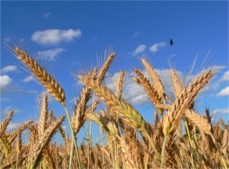Wheat

Wheat is probably the world's most important staple crop. It is a cool season crop and grows well in the UK climate which, owing to milder winters, favours autumn sown varieties. The average yield here is around 3 tonnes per acre (7.5 T/Ha). This is not a bad figure in world terms, but falls well short of the genetic potential of modern varieties, which is about 15t/ha on the best soils with the best agronomy in a perfect season.
Several factors regularly reduce yield. Wheat is susceptible to drought in the autumn and spring; a problem amplified on light sandy soils. Soil type, tillage, sunshine hours and the variety grown are important. For most farmers, the aim is to balance the best yield for the most cost-effective inputs. It is all too easy to "buy" the extra yield at a cost that exceeds the return on less than perfect soils.
The Field Science approach, as with all other crops, is always to do a full soil analysis, not just NPK. Even on good soils there are deficiencies of mineral micronutrients that in themselves limit potential yield. This leads to persistent over-use of nitrogen fertiliser, which is expensive and unnecessary. If a desired yield can be achieved with less fertiliser, the crop is less susceptible to disease and needs less chemical intervention.
Controlling input costs is vital in all but the bumper years if a decent profit is to be made. The actual margin achieved is always subject to market forces. As wheat prices fluctuate year to year, month to month and day by day, knowing when to sell is as important as knowing how to grow it, but if you get that right and your yield to input cost ratio is favourable, your profit will always exceed your neighbour's.
The Dressing Process
Field Science tailored mineral dressings are always based on detailed soil analysis of the field to be treated. A member of our technical team will visit your farm to discuss and identify where we can help. Soil samples are then taken and the tailored dressings are based on the independent laboratory’s results.
The dressings are available in two concentrations:
1 Year Dressing is cheaper per acre and is essential if the soil is ploughed after harvest or if the soil is extremely sandy.
Full Dressing is formulated to last for 2 - 3 seasons from application (subject to nutrient retention qualities of the field). This dressing is cheaper in the long run given the longevity and the cost of application only once every 2 - 3 years but the soil must not be ploughed in this time. Min-tillage is perfectly acceptable.
The best time for application is just after emergence in the case of spring wheats and February/March for winter sown wheats. This avoids any particularly wet weather.
The application rate is usually 25kg per hectare (10kg/ac) and the most effective method of application is to use an electric spinner (slug-pelleter) on a quad bike. The dressings are packed in 25kg bags, clearly labelled with the farm details, field name, application rate and bag weight.
